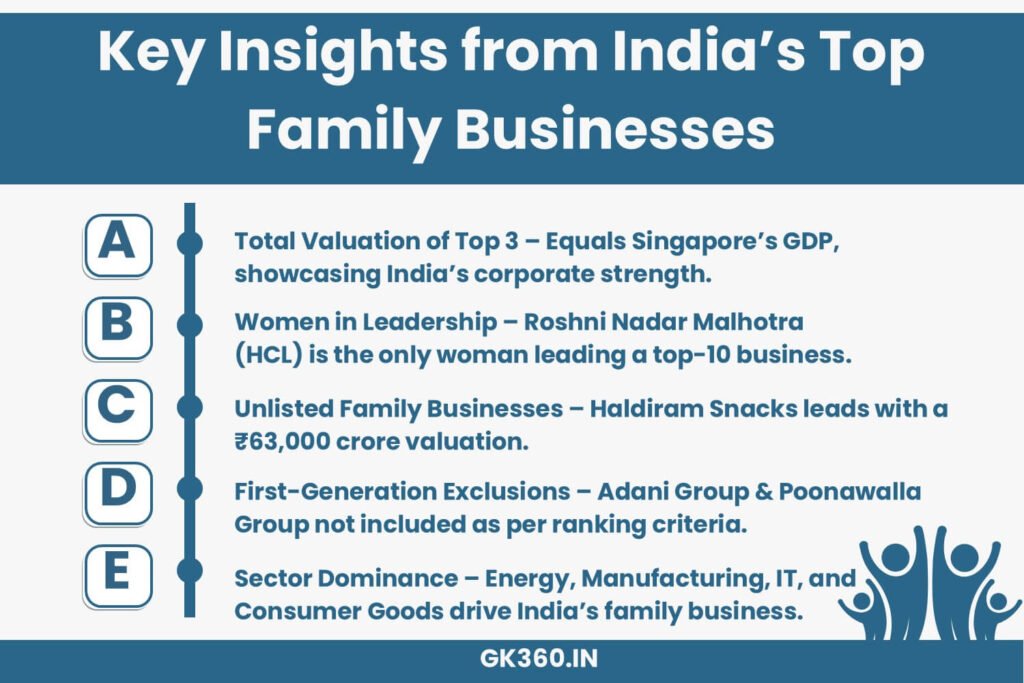India’s Most Valuable Family Businesses 2024: Insights from the Hurun Report
Introduction
Family businesses have long been the backbone of economies worldwide, and India is no exception. These enterprises contribute significantly to GDP, employment, and industrial innovation. The 2024 Barclays Private Clients Hurun India Most Valuable Family Businesses List highlights the leading Indian family-run enterprises that shape the nation’s economy. This article breaks down the top players, key insights, and how understanding these businesses can aid competitive exam preparation.

Table of Contents
- Top 5 Most Valuable Family Businesses
- Other Notable Family Businesses
- Key Insights and Learnings
- Challenges and Future Outlook
- FAQ Section
- Conclusion
Top 5 Most Valuable Family Businesses
- Ambani Family (Reliance Industries)
- Valuation: ₹25.75 lakh crore
- Sector: Energy, Retail, Infrastructure
- Leader: Mukesh Ambani
- Key Insight: Reliance Industries alone holds a valuation equivalent to 10% of India’s GDP, highlighting the dominance of conglomerates in India’s economic structure.
- Bajaj Family (Bajaj Group)
- Valuation: ₹7.13 lakh crore
- Sector: Automotive
- Leader: Niraj Bajaj
- Key Insight: The Bajaj Group represents the strength of India’s traditional manufacturing sector, demonstrating resilience and innovation.
- Birla Family (Aditya Birla Group)
- Valuation: ₹5.39 lakh crore
- Leader: Kumar Mangalam Birla
- Key Insight: This family’s diversified investments help hedge against market volatility and ensure long-term sustainability.
- Jindal Family (JSW Group)
- Valuation: ₹4.71 lakh crore
- Leader: Sajjan Jindal
- Key Insight: The steel industry remains a crucial pillar of India’s industrial expansion and infrastructure growth.
- Nadar Family (HCL Technologies)
- Valuation: ₹4.30 lakh crore
- Leader: Roshni Nadar Malhotra
- Key Insight: The only woman-led business in the top 10, showcasing the increasing influence of women in the tech sector.
Other Notable Family Businesses (6th-10th positions)
- Mahindra Family (Mahindra & Mahindra) – Automotive & Agribusiness
- Dani, Choksi, and Vakil Families (Asian Paints) – Consumer Goods
- Premji Family (Wipro) – IT Services
- Singh Family (DLF) – Real Estate Development
- Murugappa Family (Tube Investments of India) – Diversified Sectors
Key Insights and Learnings
- First-Generation Family Businesses: The Adani Family (₹15.44 lakh crore) and Poonawalla Family (₹2.37 lakh crore) are excluded due to their first-generation status.
- Unlisted Family Businesses: Haldiram Snacks leads this category with a valuation of ₹63,000 crore, highlighting the potential of consumer goods in the private sector.
- Comparative Valuation: The combined valuation of the top three families is equivalent to Singapore’s GDP, demonstrating the economic influence of Indian conglomerates.
Challenges and Future Outlook
- Succession Planning: Many family-run businesses face generational leadership transitions that can affect stability.
- Regulatory Challenges: Increasing government regulations on corporate governance may reshape the structure of family-led businesses.
- Globalization & Competition: With rising international competition, Indian businesses must innovate to maintain leadership.
FAQ Section
- Why are family businesses important in India’s economy? Family businesses contribute significantly to GDP, employment, and industry innovation, ensuring economic stability.
- How does the Hurun India report rank family businesses? The ranking is based on company valuation, market capitalization, sector dominance, and leadership structure.
- What sectors dominate India’s most valuable family businesses? Energy, manufacturing, IT, infrastructure, and consumer goods are the most dominant sectors.
- Which Indian family businesses are unlisted but highly valued? Haldiram Snacks is a prime example, leading the unlisted category with a ₹63,000 crore valuation.
- How can this data be useful for competitive exams? Understanding major business players, their economic impact, and sector-wise contributions can aid in answering general knowledge, economics, and business-related questions in exams.
Conclusion
For competitive exams, this list is not just about memorizing names and numbers. It provides insights into India’s economic structure, business leadership, and industrial trends. Family-run businesses continue to play a pivotal role in India’s economic success, influencing policy decisions and global business trends.
Key Takeaways Table
| Aspect | Details |
|---|---|
| Most Valuable Family Business | Reliance Industries (₹25.75 lakh crore) |
| Leading Sectors | Energy, Manufacturing, IT, Consumer Goods |
| First-Generation Businesses Excluded | Adani Group, Poonawalla Group |
| Top Unlisted Business | Haldiram Snacks (₹63,000 crore) |
| Women Leadership Representation | Roshni Nadar Malhotra (HCL Technologies) |
| Sector with Highest Growth | IT & Infrastructure |
| Future Challenges | Succession planning, globalization, regulatory hurdles |
Related Terms:
- India’s Most Valuable Family Businesses 2024
- Top Indian Family Businesses Hurun Report
- Richest Indian Family Business Leaders
- Reliance Bajaj Birla Family Business Ranking
- Hurun India Family Business List 2024
- India’s Biggest Conglomerates and Business Families
- Unlisted Family Businesses in India 2024
- Haldiram Snacks Valuation 2024
- Women Leaders in Indian Family Businesses
- Economic Impact of Indian Business Families






